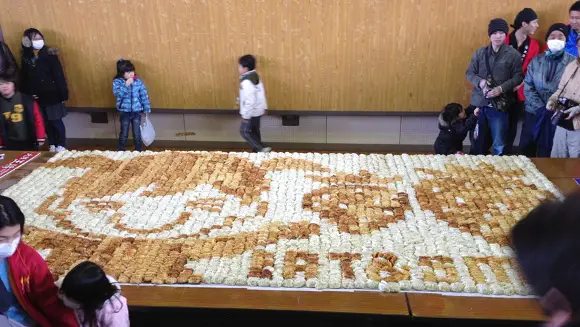
This week marks 3 years since the 2011 Tohoku earthquake - known in Japan as the Great East Japan Earthquake - which struck 70 km (43 mi) off the nation's coast on March 11, 2011. The ensuing devastation resulted in the loss of more than 15,000 lives.
Guinness World Records continues to express its deepest condolences for all those lost in the tragedy, as well as sincere sympathies for all others affected.
Since then, many groups and organizations in Japan have undertaken successful record attempts to encourage the victims and raise the spirits of Tohoku, the area affected most by the earthquake and resultant huge tsunami. Here are some of the records broken in that time.

The longest line of skiers consisted of 290 participants and was achieved by Iwate Ski Place Association, Iwate Winter Resort Kyougikai, and Hachimantai Resort (all Japan) at Hachimantai Resort in Iwate, Japan, on March 17, 2013.
Children who suffered from the earthquake were invited to the event, which was held in the same location as the previous record, set the year before.
“There are many financial ways to support the victims of the earthquake," said event organiser Mr. Tomii, of the Hachimantai Resort, "but I wanted to cheer up the children of Tohoku and to create an unforgettable happy memory by challenging Guinness World Records.”

The earthquake's tsunami also caused a number of nuclear accidents in the city of Fukushima. To prove that the city had bounced back, the Fukushima-based Jin Corporation organized the largest hiyashi chuka on July 29, 2012.
It weighed 102 kg (224 lb 13 oz) and was presented at Machinaka Hiroba, Fukushima, Fukushima, Japan. Hiyashi chuka is a ramen noodle-based dish served with various toppings in the summer. This particular event was organised to promote cucumbers grown in Fukushima.
Another large food event held in suport of earthquake victims was the largest gyoza mosaic. Gyoza are a popular type of dumpling.

The mosaic measured 8.12 m² (87.62 ft²) and contained 5,874 gyozas. It was created by Eat & Co. (Japan) at the Central Community Center in Wataricho, Miyagi, Japan, on March 20, 2012.
The mosaic represented a girl and two strawberries with the text "Eat & Smile" (pictured at the top of this article). After the record, the gyozas were distributed to the people who came to the event.

Supportive record-breaking also spread to the individual level. Two records were challenged at a school in Miyagi by professional dog circus “Super Wan Wan Circus” to raise money for charity and boost children's morale. The attempts were a highlight of the May 19, 2011 fundraising event for the 2011 earthquake.
On the day, the most jumps over a moving human leg by a dog in 30 seconds was set at 34 by the Uchida Geinousha "Super Wan Wan Circus." And the most rotations around a human neck by a dog in 30 seconds was set at nine.
This record would later be set at 11 by the same group and and Nozomi the dog on the set of "100 Handsome Men and Beautiful Women," at the Kojimachi NTV studio in Tokyo on Nov. 13, 2011.
Meanwhile, the World's Largest Rice Ball Mosaic Art Project created - you guesssed it - the largest rice ball mosaic at Shibuya Public Hall in Shibuya, Tokyo, Japan, on March 11, 2013.

It measured 113.96 m² (1,226 ft² 100 in²) and used 31,100 onigiri rice balls in six different colours to form the mosaic image.
It was organized by university students in Tokyo and Fukushima to promote the rice made in Fukushima and to share the rice balls with visitors.
And lastly, another record helped involve the children affected by the natural disaster. The longest line of casterboarders consisted of 152 participants by Team Brave and Makkou Sho-bu Project Jikkou Iinkai at the Rinkai Disaster Prevention Park in Koto, Tokyo, Japan, on Feb. 24, 2013.

Children from Fukushima were invited to this event and the age of participants varied from 8 to 47 years old. A total 39 of the overall 152 participants had participated in the previous year's same record attempt, and thus managed to break their own record.
The Olympic athlete Tsugiharu Ogiwara (a Japanese nordic combined skier whose career spanned from 1994-1998) came to encourage the challengers on the day.
“I was sometimes scared and nervous before the Olympics and the World Championships," Ogiwara told the crowd, "but when I felt 'I can do it!' and overcame my fear, I did it!”
The organisers explained their aim for this challenge in the following statement.
“Children in Tohoku are lacking exercise, especially in Fukushima, which is a serious problem. Many kids get injured so easily just by running around a little. Casterboard is an excellent sport to stay fit, so we planned to challenge this Guinness World Records title. We wanted to tell the kids to not give up and forget their hope. For example, becoming an athlete in the future, and to motivate them giving the experience of becoming the world’s best.”

The last three years have certainly shown a "Never give up" spirit from the citizens and record-breakers of Japan. At Guinness World Records, we continue to remember those affected by this tragedy and hope for a brighter future in Japan.
Asumi Funatsu is a Guinness World Records staff member based in GWR's Tokyo offices.
